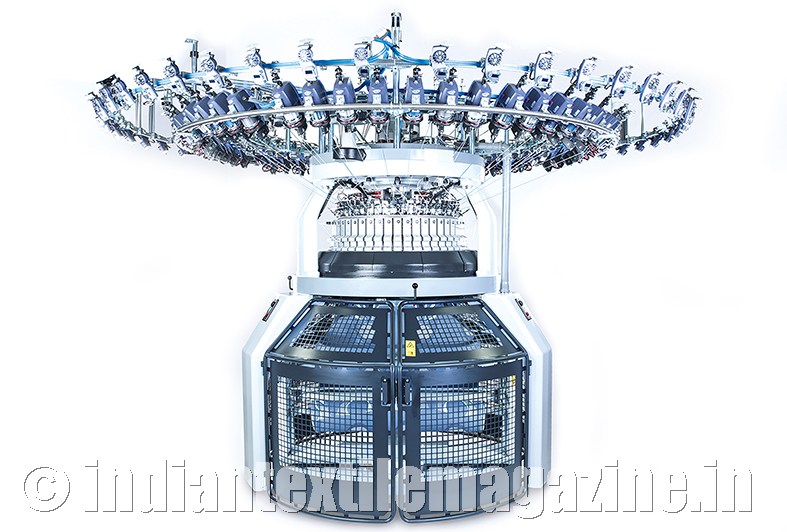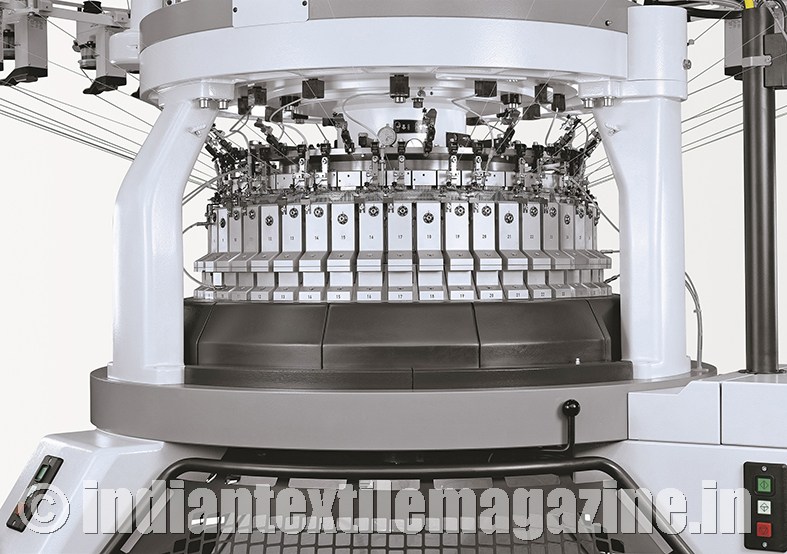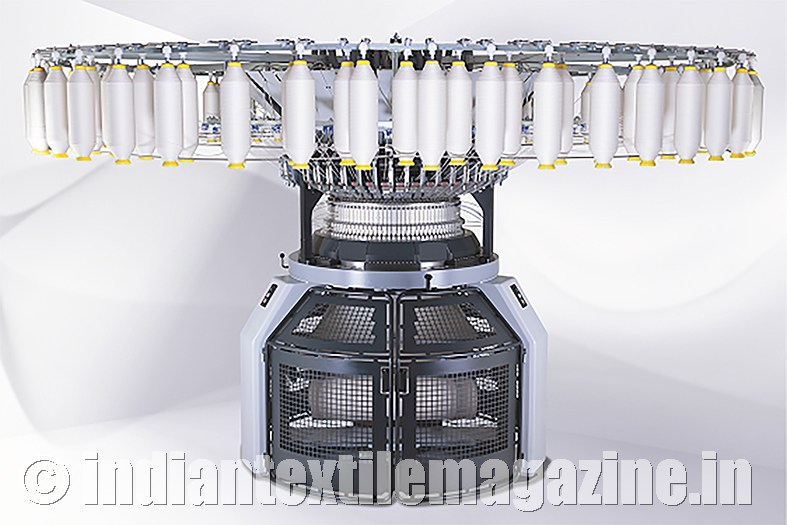Launches machines for new product segments
Mayer & Cie, the global leader in the knitting technology, is preparing for the next phase of growth. The company has started series production of its Spinit 3.0E. It will be interesting to see how this machine makes its impact, particularly in markets like India. Mayer & Cie has also launched its first specially designed machine for shoe making, which will be an important segment for the company to penetrate in the future. At ITMA Asia, Mayer & Cie will launch its first electronic jacquard machine. Although 2018 has been an average year for it, the company has been focussing on the new products, segments, markets and on its digitisation initiative. We spoke to Mr. Wolfgang Müller, Head of Sales at Mayer & Cie., to know more about the company’s performance in 2018 and its future plans.

How was the year 2018 for Mayer and Cie?
The year has definitely been an eventful one. Let me start with our least visible yet very influential project: We implemented our new ERP-system forming the basis for further steps in the digitalisation process.
We also started series production of our spinning and knitting machine Spinit 3.0 E. It combines spinning, cleaning and knitting in one single machine – a machine that is not much bigger than a conventional circular knitting machine. Earlier this year, the German Federal Environment Ministry (BMUB) and the Federation of German Industries (BDI) awarded us the Climate and Environment Innovation Prize (IKU) for spinit systems technology. One of the reasons it could come into operation is relative technology. This technology and Relanit machines are celebrating their 30th anniversary this year. Our Relanit 3.2 HS, the latest model in the Relanit family, is a much sought after machine worldwide.
Speaking of machines, there are interesting news from our Chinese works. There we completed final assembly of our 1000th machine in late spring. Our jubilee machine was a MSC 3.2 II, the best-selling model in our Chinese product line-up. To this line-up we have added the first electronic machine just now. Our OVJA 2.4 EC is a full jacquard machine with 2.4 feeders per inch, aimed at discerning Chinese customers. It outperforms local manufacturers’ conventional models in productivity.
At our headquarters in Albstadt, Germany, we are preparing for the integration of a new product. Braiding machines are successful products of the US sister company, Mayer Industries, in Orangeburg, South Carolina. Founded in the early 1970s as a Mayer & Cie. subsidiary and a circular knitting machine production site, the company is to be wound up in the medium term. Mayer Industries’ products, those machines for the manufacture of hose tubing, are to be made from about 2019 in Albstadt-Tailfingen.
Which was the key growth market globally?
In the first half of 2018, Turkey was one of our strongest markets. Over the previous year or so, its volume had nearly doubled. At ITM, we still expected 2018 to be an exceptional year, one of the best ever. Then, with the drop in value of the Turkish lira, things changed almost overnight. That and the US trade policy in general have made an impact on the other emerging markets such as Brazil and Argentina, slowing down demand there.
In India, another one of our strongest markets, demand has declined over the past months, too. Reasons are manifold.
Did you launch any new machine in the current year?
Yes, we have launched our first specially designed shoe machine, the OVJA 1.6 EE 3/2 WT. With this machine, we can cater for this important growth market’s demands.
Our OVJA 1.6 EE uses a three-way technology in the cylinder and a two-way technology in the rib dial. That ensures a very wide range of patterns in multi-colour jacquard fabrics. At the same time, the machine can produce a hole structure look by means of multiple tuck loops. It also produces plain and multi-coloured spacer fabrics up to 5 mm thick. Producing spacer fabrics on a circular knitting machine makes sense for several reasons. For one, set-up times are much shorter than when using other means of production. A circular knitter also uses much less yarn to make multi-coloured spacer fabrics. That, above all, makes manufacturing small batches of spacer on a circular knitting machine a winner. It means more flexibility and a significantly lower price.
Furthermore, we have worked on further improving our OVJA 2.4 E, arriving at a signature mattress ticking machine named OVJA 2.4 EM. It comes with higher rpm and 50 per cent more feeders, leading to a tremendously higher productivity. The machine also works with our improved thread fluctuation control system (patent pending), which ensures a constant thread tension on its way to the needle.
Naturally, with ITMA in Barcelona round the corner, we definitely have much more up the sleeve. Yet, you will have to wait until spring next year to learn more about what that is…
What will be the highlight of your participation in ITMA Asia 2018?
At ITMA Asia, we will be displaying three machines, three E-machines to be precise. All three machines are going to celebrate some sort of premiere in Shanghai. For Spinit 3.0 E, our spinning and knitting machines working with our technology spinitsystems, it is the first time it will be shown in China. Although we have already introduced Spinit 3.0 E in China, we only presented a functioning model in the past. We are happy about this opportunity: The technology, how it works and, above all, the result are always demonstrated most impressively on the machine itself.
Furthermore, customers will be able to get to know our first “proper” shoe machine, the OVJA 1.6 EE 3/2WT, which will also make its first appearance on the Chinese soil in Shanghai. We have talked about its features and advantages in the previous questions.
Finally, yet importantly, there will be our new OVJA 2.4 EC. It is the first electronic jacquard machine to be finally assembled at our works in Shanghai. It is aimed at discerning Chinese customers who produce fabrics for outer garments, sports- and leisurewear. With its 2.4 systems per inch, it outperforms local manufacturers’ conventional models in productivity. Furthermore, the OVJA 2.4 EC offers great variety in design patterns, thanks to its three-way technology. Another important benefit is the machine’s user friendliness as gauge changes are fast and easy. This is due to the thermal electromagnetic actuators on which the OVJA 2.4 EC’s needle selection is based. That means it is attractive in terms of pricing combined with high productivity. Not to mention easy spareparts availability for it being a domestic system.
Industry 4.0 seems to be the hottest topic of the global textile machinery industry. How is your organization geared up to meet Industry 4.0?
Industry 4.0 definitely is a topic that concerns our industry, too. However, it has not yet hit us with the force we are aware of from, say, the media. We are using this “delay” to take a considered, systematic approach.
In recent years, we have sought to lay firm foundations for digital change and updated our ERP-system, forming the basis for further modules. Sales, service and customer care are to benefit in the future from the digital possibilities. Our existing customer data is first to be centralized and systematized. Naturally, we already have a tremendous amount of knowledge about the markets, our customers and all the different needs to which they are subject. Yet, this knowledge exists as ‘head knowledge’ somewhere between here and Argentina, but it is not available at short notice for evaluation. Our aim is to bundle it by means of various systems to arrive at a multi-channel strategy.
In addition, a new communication tool is to make it easier to communicate within the Group and to share information with sales partners around the world.
With all these activities, we focus on the client who in the future is to receive yet better consultancy and to find shorter processes. There also is, for example, a web-shop in planning, which will facilitate ordering of spareparts and consumables.
How was your company’s business, particularly in Asian markets, during the current year? Can you highlight some important milestones?
Overall, our business year has been quite average so far. We have talked about this earlier. China, India and other Asian countries are no exception. However, we are still shipping a big number of machines to India, for instance. It is one of our most important markets. Although incoming orders from India have declined, we experienced a very strong demand previously and are currently equipping many customers with new machines.
A major project which we have executed in India this year involves our D4 2.2 HPI. This high-performance circular knitting machine comes with 4.4 systems per inch and delivers the world’s highest production output for interlock fabrics. We have shipped a very significant number of these machines to an Indian spinning mill focusing on synthetic fibres. The owner is eager to engage in forward integration and further process his output of synthetic yarns. With his extensive machine park of D4 2.2 HPI, he will now be able to process it into high-quality interlock fabrics.
Another two quite extensive projects are under way in Uzbekistan. We will deliver several dozen machines to two clients there. This is particularly pleasing as this raise in demand obviously is a positive effect of the Uzbek Government’s support programmes on the local textile industry. The Government is eager to keep the textile value chain within the country’s borders. In the past, Uzbekistan has exported a vast share of its cotton produce to other countries.
Just as Uzbekistan’s textile industry profits from Government activities, Iran’s industry is subject to global politics. Over the past two years or so, we saw an economical recovery in Iran. Prospects for us as a circular knitting machine manufacturer were very promising, just as for all German textile machinery manufacturers in general. Now, after the US withdrawal from the nuclear agreement and sanctions back in place, there is not much room left for Irian customers.


